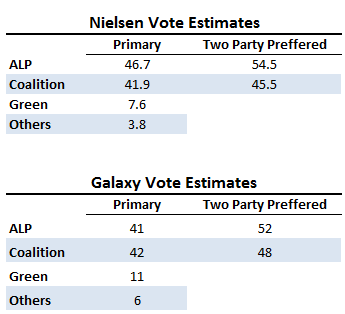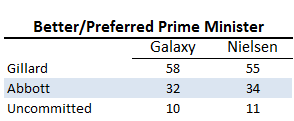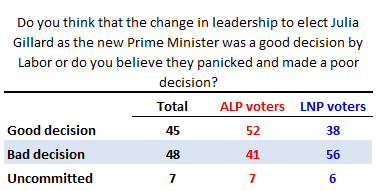Today brings about the first robust polling of the Gillard era (there were a few not so robust jobbies floating around yesterday in the media using instapundit online panels – ignore them, they may well have had big sample sizes, but their sampling frame isn’t up to the job required for political polling.)
We have a Nielsen in Fairfax and a Galaxy in the News Ltd tabloids. The Nielsen ran from a sample of 933, giving us an MoE that maxes out around the 3.2% mark (demographic tables here), while the Galaxy was a sample of 800 giving us an MoE that maxes out around the 3.5% mark.
The first thing to mention about these polls is what they don’t measure. As a result of them being in the field on Thursday night in the case of Galaxy and both Thursday and Friday nights in the case of Nielsen – they wont be measuring a proper voting intention, but instead measuring an initial public reaction. We’ll have to wait for a week or so for the phrase “Prime Minister Gillard” to sink into the public brainspace before we can start to get a confident grip on the voting intention fallout.
As a result, don’t be surprised to see quite a large variation in polling results over the next polling cycle.
First up, the headline figures for the pollsters came in like this -I’ve also got higher resolution Nielsen data, so we’ll run the Nielsen results to a decimal place.
Earlier this month, Nielsen came out with a two party preferred of 53/47 to the Coalition – a few points undercooked for Labor based on our polling trends at the time and a result not replicated by any other pollster. So the size of the turnaround here in terms of initial public reaction is probably slightly overcooked for Labor. The last time Galaxy was in the field was mid-May – so using that as our baseline, Galaxy comes in with a two party preferred of 52/48 compared to May’s 50/50 result. If we look at the May result for Nielsen, it came in at 50/50 as well.
If we compare the primary votes of the parties and how they’ve changed since May, this is what we end up with:
Both pollsters show a drop in the Others vote and the Greens vote – although Nielsen shows a considerable Greens drop of 5 points. Also worth noting is how the Coalition vote didnt really move a jot on either pollster’s results. The initial public reaction to Gillard seems to be identical to the medium term public reaction to Abbott – it has encouraged skeptical partisans and ordinarily soft voters back into the fold.
You might remember recently we were looking at how Greens preference flows had been changing over time – with increasing numbers of Greens voters giving their preferences to the Coalition, dragging Greens to Labor preference flows down to as low as 68%. Today’s Nielsen poll has those flows bouncing back up substantially.
Meanwhile, the Better/Preferred PM beauty contest came in like this:
Galaxy also asked a few additional questions, the first if which was on whether the public agreed with removing the PM.
The next looked at responsibility sharing, where Galaxy asked:
Considering some of the controversial issues that have dogged Labor, including the delay of the ETS and the introduction of the Resources Super Profits Tax. On balance do you believe that Julia Gillard should share the responsibility with Kevin Rudd for the decisions made or do you believe that Kevin Rudd was mainly responsible for those decisions?
Finally, Galaxy asked:
In your opinion, which one of the two leaders, Julia Gilard or Tony Abbott, is best described by each of the following words or phrases?
I’ve highlighted the “trust” results which is still Abbott’s biggest weakness, especially now that Rudd – who was struggling himself in the trust stakes – has been replaced by someone who has a clean slate on that measure.














Crikey is committed to hosting lively discussions. Help us keep the conversation useful, interesting and welcoming. We aim to publish comments quickly in the interest of promoting robust conversation, but we’re a small team and we deploy filters to protect against legal risk. Occasionally your comment may be held up while we review, but we’re working as fast as we can to keep the conversation rolling.
The Crikey comment section is members-only content. Please subscribe to leave a comment.
The Crikey comment section is members-only content. Please login to leave a comment.